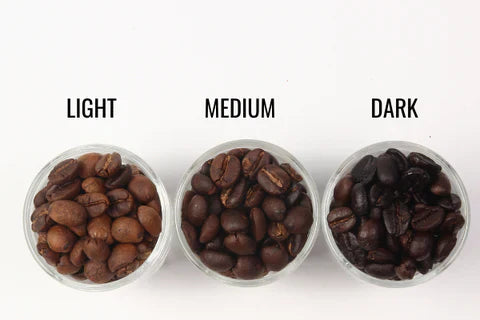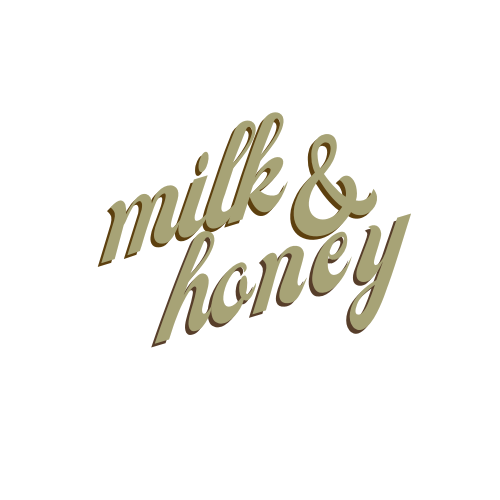
What’s the Difference Between Light, Medium, and Dark Roast Coffee? Here’s What You Need to Know
Share
TLDR;
Light, medium, and dark roast coffees differ in flavor, acidity, body, appearance, and caffeine content based on how long and hot the beans are roasted. Light roasts are brighter and more acidic, medium roasts are balanced and smooth, and dark roasts are bolder with less acidity.
Understanding the Coffee Roasting Process

Roasting transforms green coffee beans into the aromatic, flavorful brews we enjoy every day. It’s a heat-driven process where time and temperature change the chemical makeup of the beans—shaping their taste, texture, and caffeine content.
Key points during roasting:
-
First Crack (around 385°F): The point when the beans pop, signaling light roast.
-
Second Crack (around 435°F): A deeper crack where medium becomes dark roast.
As beans roast, the Maillard reaction and caramelization develop deeper flavors, change acidity, and create aroma. Lighter roasts keep the bean’s natural characteristics. Darker roasts emphasize the roast itself—bold, smoky, and bitter.
Coffee Roast Types Explained: Light vs Medium vs Dark Roast

Each roast level offers a unique flavor and aroma profile. Understanding these differences helps in choosing the right one for your taste and brewing method.
Light Roast Coffee
-
Roast Temp: 350–400°F (ends at first crack)
-
Color & Surface: Light brown, dry surface
-
Flavor: Bright, fruity, floral, citrusy
-
Body: Light and crisp
-
Acidity: High
-
Caffeine: Highest per weight due to bean density
-
Ideal Brewing: Pour-over, Chemex, AeroPress
Light roasts preserve more of the bean’s original flavors and often reflect the region and growing conditions clearly.
Medium Roast Coffee
-
Roast Temp: 400–430°F (between first and second crack)
-
Color & Surface: Medium brown, little to no oil
-
Flavor: Balanced, nutty, caramel, chocolate notes
-
Body: Smooth, medium-bodied
-
Acidity: Moderate
-
Caffeine: Slightly less than light roast
-
Ideal Brewing: Drip machine, French press, cold brew
Medium roasts strike a balance between the origin character and roast flavor, making them a versatile choice—especially in Understanding Coffee Blends, where medium roasts often serve as the foundation for smooth, balanced profiles.
Dark Roast Coffee
-
Roast Temp: 430–480°F (into second crack)
-
Color & Surface: Dark brown to black, shiny with oil
-
Flavor: Bold, smoky, bittersweet, earthy
-
Body: Heavy and full-bodied
-
Acidity: Low
-
Caffeine: Lowest per scoop
-
Ideal Brewing: Espresso, moka pot
Dark roasts deliver intense flavor and are ideal for those who prefer bold, low-acid coffee.
Coffee Roast Comparison Chart
|
Roast Level |
Temp (°F) |
Color & Surface |
Caffeine |
Acidity |
Flavor Profile |
Best Brew Method |
|
Light |
350–400 |
Light, dry |
Highest |
High |
Fruity, citrus, floral |
Pour-over, Chemex, AeroPress |
|
Medium |
400–430 |
Medium brown |
Moderate |
Moderate |
Nutty, chocolate, caramel |
Drip, French press, Cold brew |
|
Dark |
430–480 |
Dark, oily |
Lowest |
Low |
Smoky, bitter, bold |
Espresso, moka pot |
How Roast Affects Coffee Flavor, Acidity & Caffeine

The degree of roast changes coffee’s chemical structure, especially:
-
Flavor Development:
-
Light roasts keep natural origin flavors
-
Medium roasts show balanced sweetness
-
Dark roasts reflect the roast process more than the bean itself
-
Light roasts keep natural origin flavors
-
Acidity:
-
Higher in light roasts
-
Balanced in medium
-
Lowest in dark roasts
-
Higher in light roasts
-
Caffeine Content:
-
Light roasts have more caffeine by scoop due to denser beans
-
Dark roasts lose mass during roasting, reducing caffeine per volume
-
Light roasts have more caffeine by scoop due to denser beans
Chlorogenic acids and sugars break down during roasting, affecting both taste and antioxidant content.
Best Brewing Methods for Each Coffee Roast

Each roast responds differently to various brewing styles:
-
Light Roast:
-
Emphasizes clarity and complexity
-
Ideal brewing: Pour-over, Chemex, AeroPress
-
Grind size: Medium-fine
-
Water temp: 195–205°F
-
Emphasizes clarity and complexity
-
Medium Roast:
-
Balanced and flexible
-
Ideal brewing: Drip, French press, cold brew
-
Grind size: Medium
-
Water temp: ~200°F
-
Balanced and flexible
-
Dark Roast:
-
Rich and bold
-
Ideal brewing: Espresso machine, moka pot
-
Grind size: Fine
-
Water temp: 195°F
-
Rich and bold
Matching roast to method brings out its best qualities.
Health Benefits of Each Coffee Roast

Each roast type has different health implications:
-
Light Roast:
-
Rich in antioxidants
-
May support inflammation control
-
Can be more acidic
- Learn more about the specific benefits of blonde roast coffee and how it compares to other light roasts.
-
Rich in antioxidants
-
Medium Roast:
-
Good antioxidant balance
-
Easier on digestion
-
A strong all-around option
-
Good antioxidant balance
-
Dark Roast:
-
Low acidity
-
Gentler on the stomach
-
Slightly lower antioxidant content due to longer roasting
-
Low acidity
Choose based on what works best for your body and taste preferences.
Coffee Roast Myths You Should Stop Believing

Let’s debunk some common misunderstandings:
-
Myth: Dark roasts have more caffeine
Truth: Light roasts typically have more per scoop due to denser beans.
-
Myth: Bold flavor means higher strength
Truth: Bold taste doesn’t mean more caffeine—it just tastes stronger.
-
Myth: Light roast is weak coffee
Truth: Light roast can have stronger caffeine effects and more origin character.
Understanding these truths helps make smarter choices.
Choosing the Right Roast for Your Taste and Routine

Here’s how to choose your ideal roast:
-
Flavor Preference:
-
Light: Bright, floral, complex
-
Medium: Balanced, sweet, nutty
-
Dark: Bold, bitter, roasted
-
Light: Bright, floral, complex
-
Brewing Method:
-
Manual: Light or medium
-
Espresso: Medium-dark to dark
-
Cold brew: Medium for smoothness
-
Manual: Light or medium
-
Health & Sensitivity:
-
Acid-sensitive? Try dark roast
-
Antioxidant-seeker? Go light
-
Daily cup? Medium roast works best
-
Acid-sensitive? Try dark roast
The right roast is about more than taste—it's also about how and why you drink coffee.
Storing Light, Medium, and Dark Roast Coffee for Freshness

Storage impacts both flavor and shelf life:
-
Best Practices:
-
Use airtight, opaque containers
-
Store in a cool, dark place (not the fridge)
-
Use airtight, opaque containers
-
Whole Beans vs Ground:
-
Whole beans stay fresh longer
-
Ground coffee loses flavor faster—use within a week
-
Whole beans stay fresh longer
-
Avoid Exposure To:
-
Light
-
Moisture
-
Heat
-
Air
-
Light
Proper storage keeps your coffee tasting fresh longer.
FAQs About Coffee Roast Levels
Which roast has more caffeine?
Light roast—more dense, retains more caffeine per scoop.
Which roast is less acidic?
Dark roast—roasting breaks down acidic compounds.
What roast is best for espresso?
Dark or medium-dark for rich crema and bold flavor.
Can I roast coffee at home?
Yes. Home roasting is possible with popcorn poppers or specialty roasters, but takes practice.
